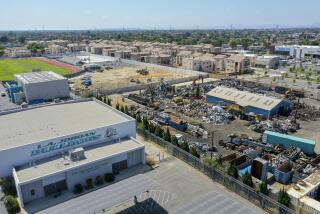Rocky Flats’ Nuclear History Leaves Legacy of Peril and Plutonium : Colorado: Making the area safe is ‘the toughest job in the United States today,’ says the man responsible for doing so. Panel has urged that cleanup be halted until it can be done right.
- Share via
DENVER — Anson Burlingame has taken to wearing a bright yellow button to remind everyone what the problem is at Rocky Flats.
“It’s the plutonium, stupid,” it reads.
Not that there was any doubt. Rocky Flats--the nuclear bomb facility 16 miles northwest of Denver--remains the home of 14.2 tons of plutonium.
It is Burlingame’s job to make Rocky Flats safe. And this, he said, is “the toughest job in the United States today. Trying to deal with Rocky Flats and the political complexities of this site are almost unbelievable.”
He doesn’t have much time. The former nuclear submarine commander was installed last March as president of EG&G; Rocky Flats, operator of the plant. EG&G; has since decided not to seek renewal of its contract, and a new operator is expected to be in place by summer.
In the meantime, there’s a lot to do. Radioactive and hazardous materials are being solidified and moved into a huge building--Building 371--where it will remain, perhaps forever, on the 100 acres of the 384-acre complex that housed plutonium production.
The rest of the 6,500 acres, most of which has been used as a buffer zone, will be turned over to the public when it is deemed safe, said Mark Silverman, site manager for the U.S. Department of Energy, which owns the plant.
As for the buildings in the production zone, they may be encapsulated with foam or concrete, “so they would be safe for the next 20,000 years, or until someone comes up with a better technology,” said Silverman.
Rocky Flats was conceived by the Atomic Energy Commission in 1951 at the beginning of the Cold War, when the Soviet Union became an emerging nuclear power. The plant began producing explosive devices for nuclear bombs in 1953.
The seeds of Rocky Flats’ problems were sown from the start.
“We put all our resources, all our attention, to winning the Cold War and we didn’t put enough attention and money into maintaining our facilities, and (into) dealing with the nuclear wastes that we were generating,” Silverman said.
This country, he said, “never worried about what do you do about plutonium in the long term, because you just kept recycling it into weapons. It was created in a reactor and was brought to Rocky Flats . . . you created a component, you gave it to the Department of Defense, and after it sat out there (in bombs) for awhile, you brought it back for recycling. It came right back to Rocky Flats. We’d recycle it and we kept making parts.”
Then the musical chairs all came to a stop, and Rocky Flats found itself with tons of potentially deadly plutonium on-site.
The plant, operated by Rockwell International at the time, was shut down in 1989 after federal agents raided the complex and found the company had allowed toxic waste to leak from outdoor containers. Rockwell eventually was fined $18.5 million, and EG&G; took over.
The plant never went into production again, and the mission of the 6,200 employees changed from production to cleanup.
Those polyethylene containers that held the extremely dangerous plutonium for a period of a few days, or weeks, were sitting in storage for years. Age took its toll on the containers. Some cracked and leaked.
Now, said Burlingame, the containers are stored in airtight “glove boxes” and are checked every day. If they show signs of deterioration, they are replaced immediately.
Still, this month an independent commission headed by Motorola Corp. chairman Robert Galvin said the Energy Department is failing to clean up Rocky Flats and other such facilities because bureaucrats rely on low-quality science and technology. It said that the cleanup should be halted until the government knows how to get the job done.
But Burlingame and Silverman agree that progress has been made since Burlingame’s new management team took over.
“We’ve exceeded our goal of low-level waste shipments to the Nevada Test Site by over 300% this summer just by rolling up our sleeves and getting some work done,” he said. And, “In productivity savings, we’ve saved over $70 million at this site in fiscal ’94 . . . by learning to do it faster, better, cheaper, while at the same time absolutely demanding and ensuring that we maintain the right safety margin.”
Silverman said six tons of uranium stored at the facility will be shipped out, probably to Oak Ridge, Tenn. Most of the equipment used to manufacture nuclear components has been sent to Los Alamos, N.M.
“It’s the plutonium that we don’t have any easy answers as to where that stuff is going to go,” he said. “So for the foreseeable future, it will be stored at Rocky Flats for five years, 10 years, 15 years. . . . “
More to Read
Sign up for Essential California
The most important California stories and recommendations in your inbox every morning.
You may occasionally receive promotional content from the Los Angeles Times.













